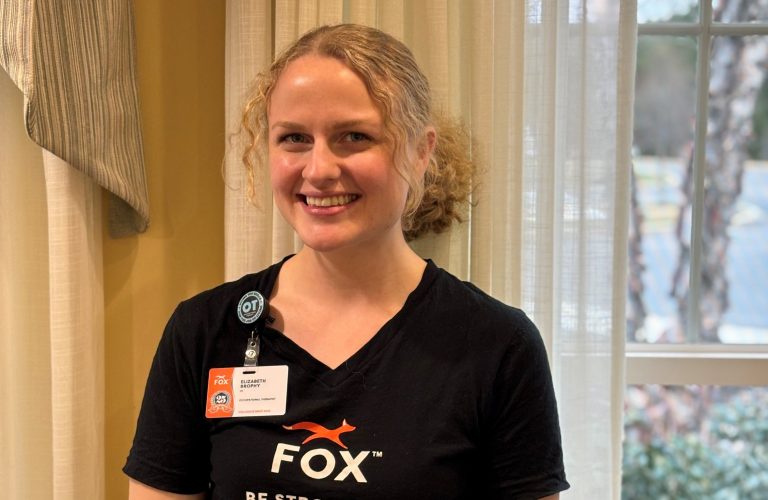Guest Blog – The Role of Occupational Therapy in Fall Prevention

In September we recognize National Fall Prevention month, to raise awareness we’ve partnered with Liz Brophy, registered Occupational Therapist and Board Certified Geriatric Clinical Specialist from FOX Rehabilitation.
Liz works with Northbridge communities, Stroudwater Lodge and Avita of Stroudwater and one of her roles as a lead clinician is with our falls prevention program. Liz provides quarterly fall recovery training for community associates and completes routine screens on each resident at move in, every 6 months, and when any falls occurs.
Check out Liz’s guest blog to learn more about the importance Occupational Therapy plays in fall prevention, and why Liz is so passionate about it.
The Role of Occupational Therapy in Fall Prevention
By Elizabeth Brophy, OTR/L, BCG
SLC Lead Clininician
FOX Rehabilitation
I’m passionate about helping older adults stay as independent as possible so they can continue doing the daily activities that matter most to them. I especially love working in memory care and supporting residents in ways that help them feel safe and confident.
Since September is National Fall Prevention Month, I’m teaming up with Northbridge to share a little about the important role Occupational Therapy (OT) plays in fall prevention, especially in senior living communities.
Why is fall prevention important?
Falls are unfortunately common for older adults:
- About 1 in 3 adults over 65 will fall each year.
- Nighttime falls often happen when someone gets up to use the bathroom.
- Daytime falls are often linked to tripping hazards or dizziness when standing up.
One of the most concerning facts is that the longer someone remains on the floor after a fall, the greater the chance of serious complications. If someone has fallen once, they’re more likely to fall again.
All this to say, falls are common for older adults both at home and in healthcare settings and minimizing that risk is essential to the health and independence of the elderly population.
How Occupational Therapy Helps
Many people are familiar with how Physical Therapy supports fall prevention, but Occupational Therapy plays a big role too. OT takes a holistic approach, meaning I look at the whole picture:
- The person – their strengths, challenges, and goals
- Their environment – how their space is set up to support or hinder them
- Their daily routines – what’s meaningful and important in their everyday life
When I work with residents, I complete a thorough safety evaluation. This means I talk with them, their families, caregivers and community associates about concerns, and observe how they complete daily activities. I may also assess things like balance, coordination, strength, or vision.
Together, we create a plan of care that focuses on what really matters to them. Therapy works best when it’s connected to daily life, things like getting dressed, cooking, or bathing because those are the activities that keep someone feeling independent.
Fall Prevention Interventions
Some examples of strategies I might recommend for fall prevention include:
- Adding grab bars and nonskid strips in the shower
- Increasing lighting, or rearranging furniture to better accommodate a walker or wheelchair
- Recommending adaptive equipment, like a reacher for picking up items from the floor
- A seat for the shower
I also focus on practical training, such as how to use a walker correctly, how to conserve energy, or how to move more safely when completing everyday tasks. Working side by side with residents in their own environment makes therapy both effective and meaningful.
Collaboration is also key—I work closely with community associates to ensure residents feel supported in their routines, making fall prevention a true team effort.
Keeping Residents Safe at Northbridge
As a lead clinician in Northbridge communities, one of my responsibilities is to provide regular screenings for residents. These quick check-ins look for changes in balance, self-care skills, or cognition. Catching something early could lead to a referral to Occupational Therapy, Physical Therapy or Speech Therapy, a preventative measure allowing us to work on potential issues early, before they lead to a fall or injury.
For families considering a senior living community, I always recommend asking about the community’s fall prevention approach and how therapy services are integrated. These programs make a big difference in helping residents feel safe, confident, and supported.
If you want to learn more about life at a Northbridge community, click here to find a location near you!